Postwall-Slotline Stepped Impedance Resonator and Its Application to Bandpass Filter with Improved Upper Stopband
Abstract
1. Introduction
2. Filter Design
2.1. Filter Structure
2.2. PWS-SIR Resonator
2.3. Filter Design
3. Fabrication and Measurement Results
4. Conclusions
Author Contributions
Funding
Institutional Review Board Statement
Informed Consent Statement
Data Availability Statement
Conflicts of Interest
References
- Mandal, M.K.; Sanyal, S. Compact Wide-Band Bandpass Filter Using Microstrip to Slotline Broadside-Coupling. IEEE Microw. Wirel. Compon. Lett. 2007, 17, 640–642. [Google Scholar] [CrossRef]
- Remillard, S.; Radzikowski, P.; Cordone, S.; Applegate, D.; Mehrotra, A.; Kokales, J.; Abdelmonem, A. A closed slot-line resonator filter. IEEE Microw. Wirel. Compon. Lett. 2004, 14, 234–236. [Google Scholar] [CrossRef]
- Sun, S.; Menzel, W. Novel dual-mode balun bandpass filters using single cross-slotted patch resonator. IEEE Microw. Wirel. Compon. Lett. 2011, 21, 415–417. [Google Scholar] [CrossRef]
- Killamsetty, V.K.; Mukherjee, B. Compact Wideband Bandpass Filter for TETRA Band Applications. IEEE Microw. Wirel. Compon. Lett. 2017, 27, 630–632. [Google Scholar] [CrossRef]
- Killamsetty, V.; Mukherjee, B. Miniaturised highly selective wide-band bandpass filter using dual-mode resonators and inter digital capacitors. Electron. Lett. 2017, 53, 1209–1211. [Google Scholar] [CrossRef]
- Feng, L.-P.; Zhu, L. Strip-Loaded Slotline Resonator for Compact Differential-Mode Bandpass Filters with Improved Upper Stopband Performance. IEEE Microw. Wirel. Compon. Lett. 2017, 27, 108–110. [Google Scholar] [CrossRef]
- Luo, X.; Ma, J.-G. Compact Slot-Line Bandpass Filter Using Backside Microstrip Open-Stubs and Air-Bridge Structure for Spurious Suppression. In Proceedings of the 2009 Asia Pacific Microwave Conference, Singapore, 7–10 December 2009. [Google Scholar]
- Azadegan, R.; Sarabandi, K. Miniature High-Q Double-Spiral Slot-Line Resonator Filters. IEEE Trans. Microw. Theory Tech. 2004, 52, 1548–1557. [Google Scholar] [CrossRef]
- Lee, J.; Sarabandi, K. A Miniaturized Conductor-Backed Slot-Line Resonator Filter With Two Transmission Zeros. IEEE Microw. Wirel. Compon. Lett. 2006, 16, 660–662. [Google Scholar] [CrossRef][Green Version]
- Lee, C.; Hsu, C.G.; Chen, C. Band-Notched Balanced UWB BPF With Stepped-Impedance Slotline Multi-Mode Resonator. IEEE Microw. Wirel. Compon. Lett. 2012, 22, 182–184. [Google Scholar] [CrossRef]
- Guo, X.; Zhu, L.; Wu, W. A Dual-Wideband Differential Filter on Strip-Loaded Slotline Resonators with Enhanced Coupling Scheme. IEEE Microw. Wirel. Compon. Lett. 2016, 26, 882–884. [Google Scholar] [CrossRef]
- Kuo, J.-T.; Shih, E. Microstrip stepped impedance resonator bandpass filter with an extended optimal rejection band-width. IEEE Trans. Microw. Theory Tech. 2003, 51, 1554–1559. [Google Scholar]
- Lopetegi, T.; Laso, M.A.; Falcone, F.; Martin, F.; Bonache, J.; Garcia, J.; Perez-Cuevas, L.; Sorolla, M.; Guglielmi, M. Mi-crostrip “Wiggly-Line” bandpass filters with multispurious rejection. IEEE Microw. Wirel. Compon. Lett. 2004, 14, 531–533. [Google Scholar] [CrossRef]
- Chen, C.-F.; Huang, T.-Y.; Wu, R.-B. Design of microstrip bandpass filters with multiorder spurious-mode suppression. IEEE Trans. Microw. Theory Tech. 2005, 53, 3788–3793. [Google Scholar] [CrossRef]
- Lin, S.C.; Kuo, T.N.; Lin, Y.S.; Chen, C.H. Novel coplanar-waveguide bandpass filters using loaded air-bridge enhanced capacitors and broadside-coupled transition structures for wideband spurious suppression. IEEE Trans. Microw. Theory Tech. 2006, 54, 3359–3369. [Google Scholar]
- Luo, X.; Ma, J.-G.; Li, E.-P.; Ma, K. Hybrid microstrip T-Stub/defected ground structure cell for electromagnetic interference bandpass filter design. IEEE Trans. Electromagn. Compat. 2011, 53, 717–725. [Google Scholar]
- Kim, C.H.; Chang, K. Wide-Stopband Bandpass Filters Using Asymmetric Stepped-Impedance Resonators. IEEE Microw. Wirel. Compon. Lett. 2013, 23, 69–71. [Google Scholar] [CrossRef]
- Chu, P.; Hong, W.; Dai, L.; Tang, H.; Hao, Z.-C.; Chen, J.; Wu, K. Wide Stopband Bandpass Filter Implemented With Spur Stepped Impedance Resonator and Substrate Integrated Coaxial Line Technology. IEEE Microw. Wirel. Compon. Lett. 2014, 24, 218–220. [Google Scholar] [CrossRef]
- Malherbe, J.A.G. Wideband Bandpass Filter With Extremely Wide Upper Stopband. IEEE Trans. Microw. Theory Tech. 2018, 66, 2822–2827. [Google Scholar] [CrossRef]
- Makimoto, M.; Yamashita, S. Bandpass Filters Using Parallel Coupled Stripline Stepped Impedance Resonators. IEEE Trans. Microw. Theory Tech. 1980, 28, 1413–1417. [Google Scholar] [CrossRef]
- Li, S.; Yin, X.; Zhao, H.; Qi, H. Post-Wall Slotline and its Application in Design of Short Pulse Tapered Slot Antennas. IEEE Trans. Antennas Propag. 2015, 63, 1. [Google Scholar] [CrossRef]
- Sagawa, M.; Makimoto, M.; Yamashita, S. Geometrical structures and fundamental characteristics of microwave stepped-impedance resonators. IEEE Trans. Microw. Theory Tech. 1997, 45, 1078–1085. [Google Scholar] [CrossRef]
- Pozar, D.M. Microwave Engineering; John Wiley & Sons: Hoboken, NJ, USA, 2009; pp. 320–322. [Google Scholar]
- Sangam, R.S.; Dash, S.; Kshetrimayum, R.S. Ultra-Broadband Bandpass Filter Using Linearly Tapered Coupled-Microstrip Line and Open Loop Defected Ground Structure. IEEE Trans. Circuits Syst. II Express Briefs 2021, 68, 181–185. [Google Scholar] [CrossRef]
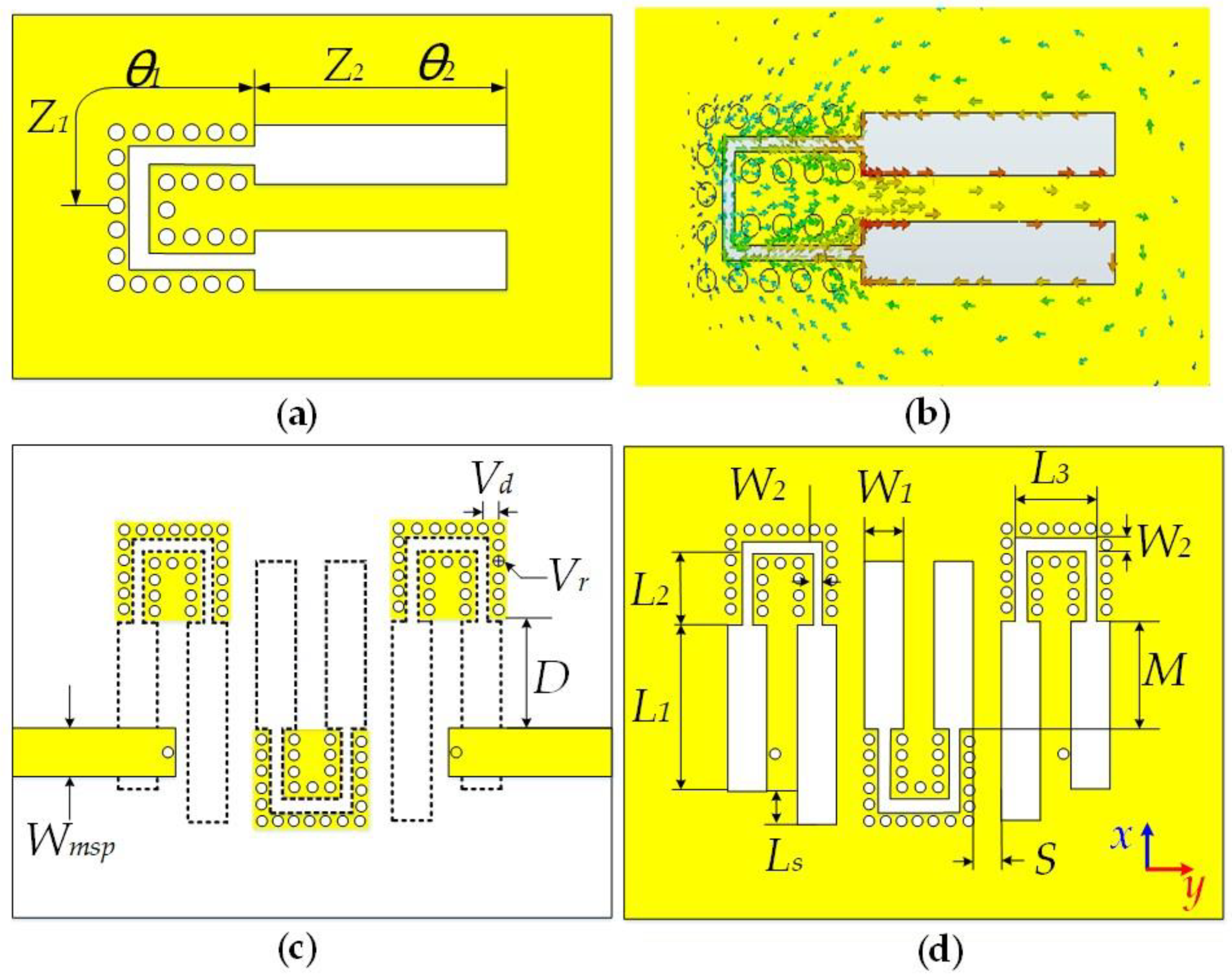
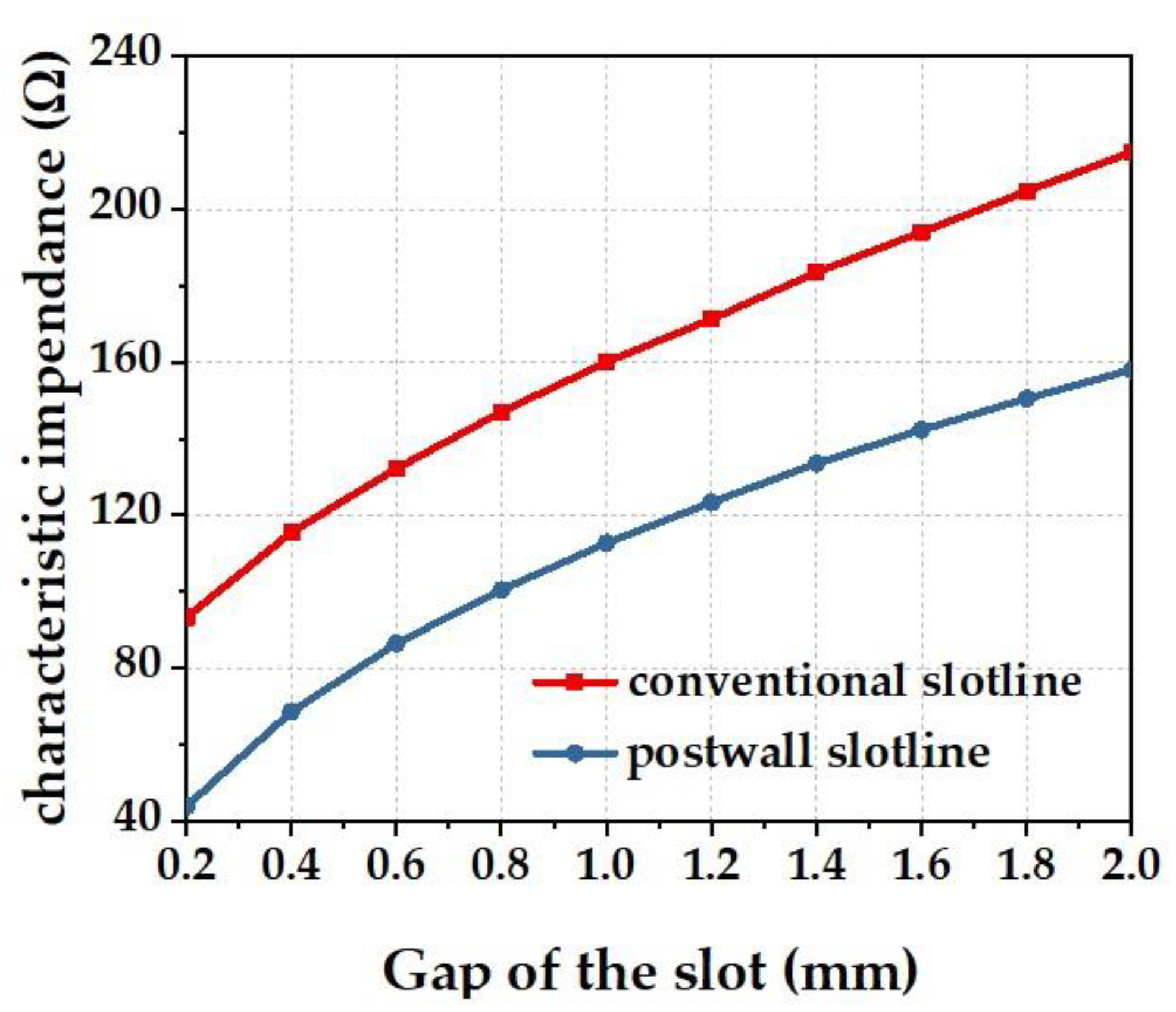
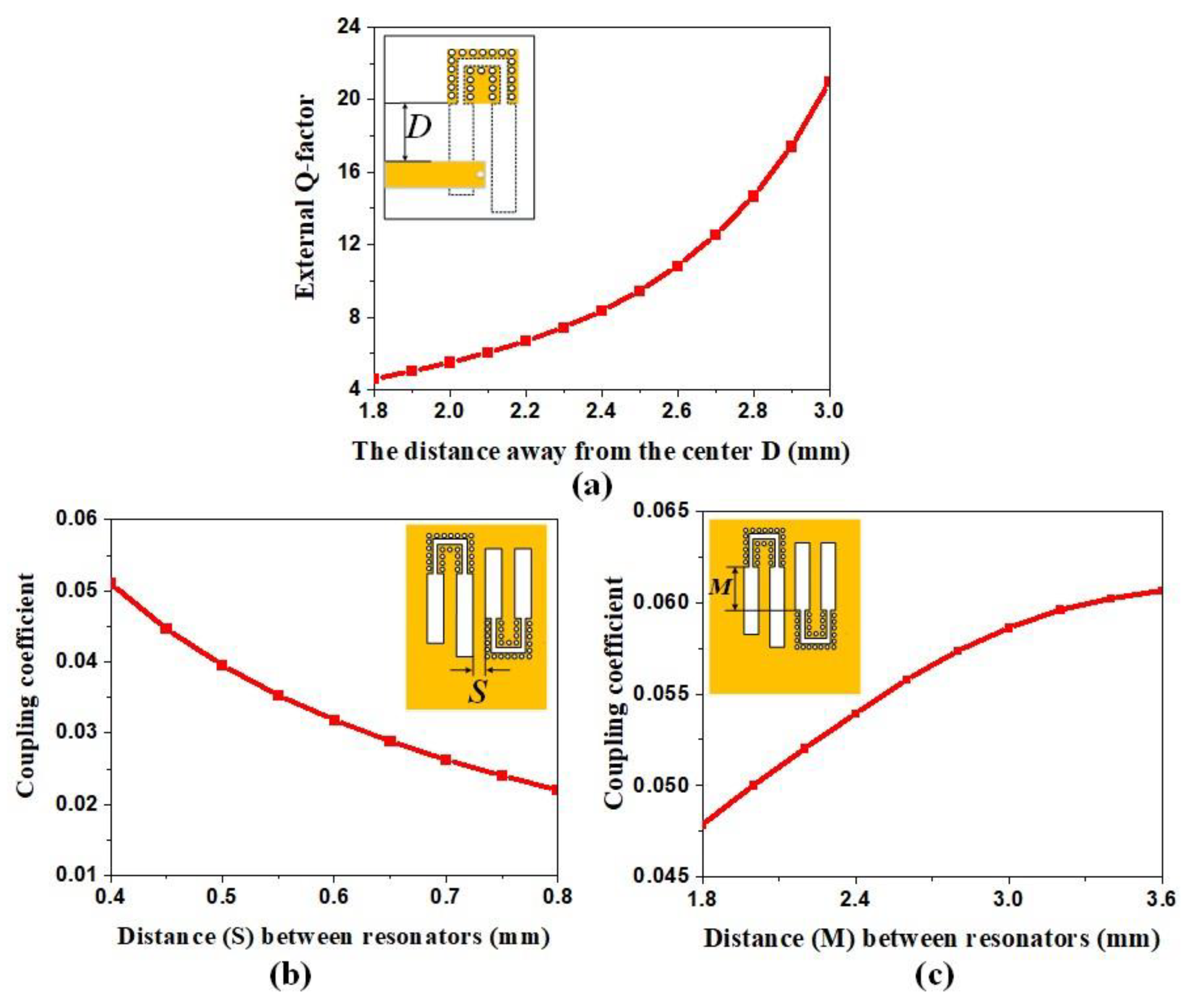
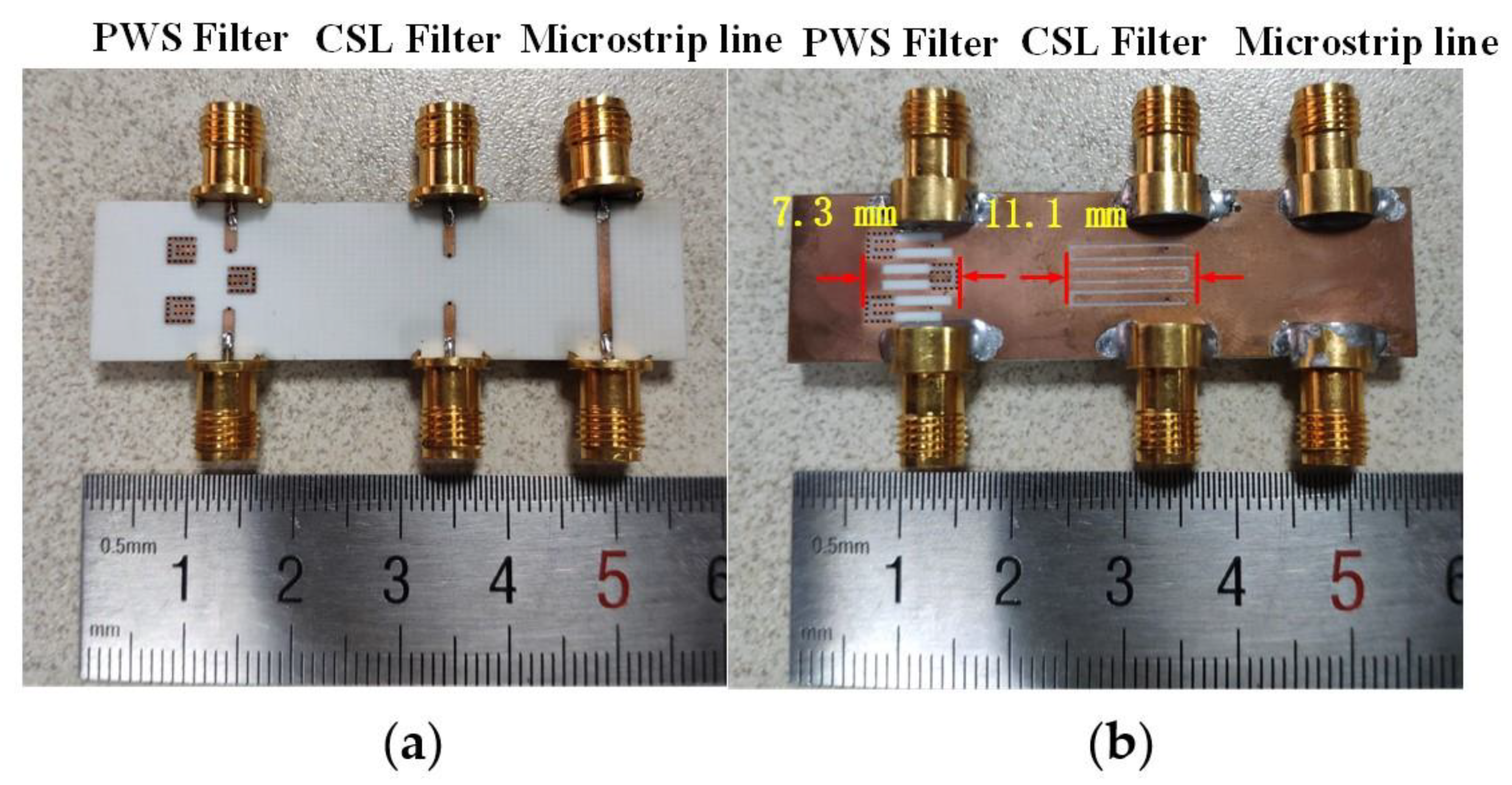
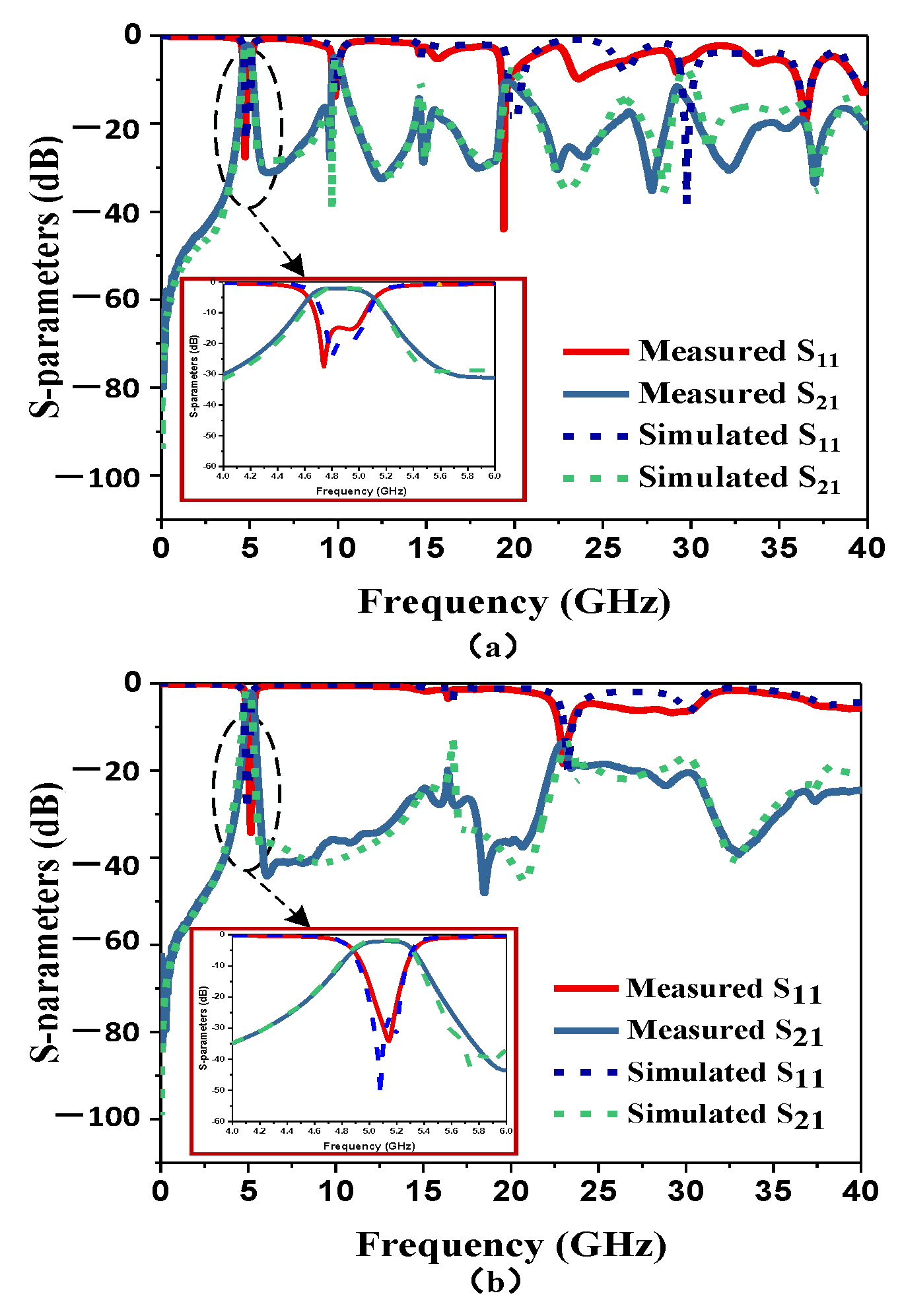
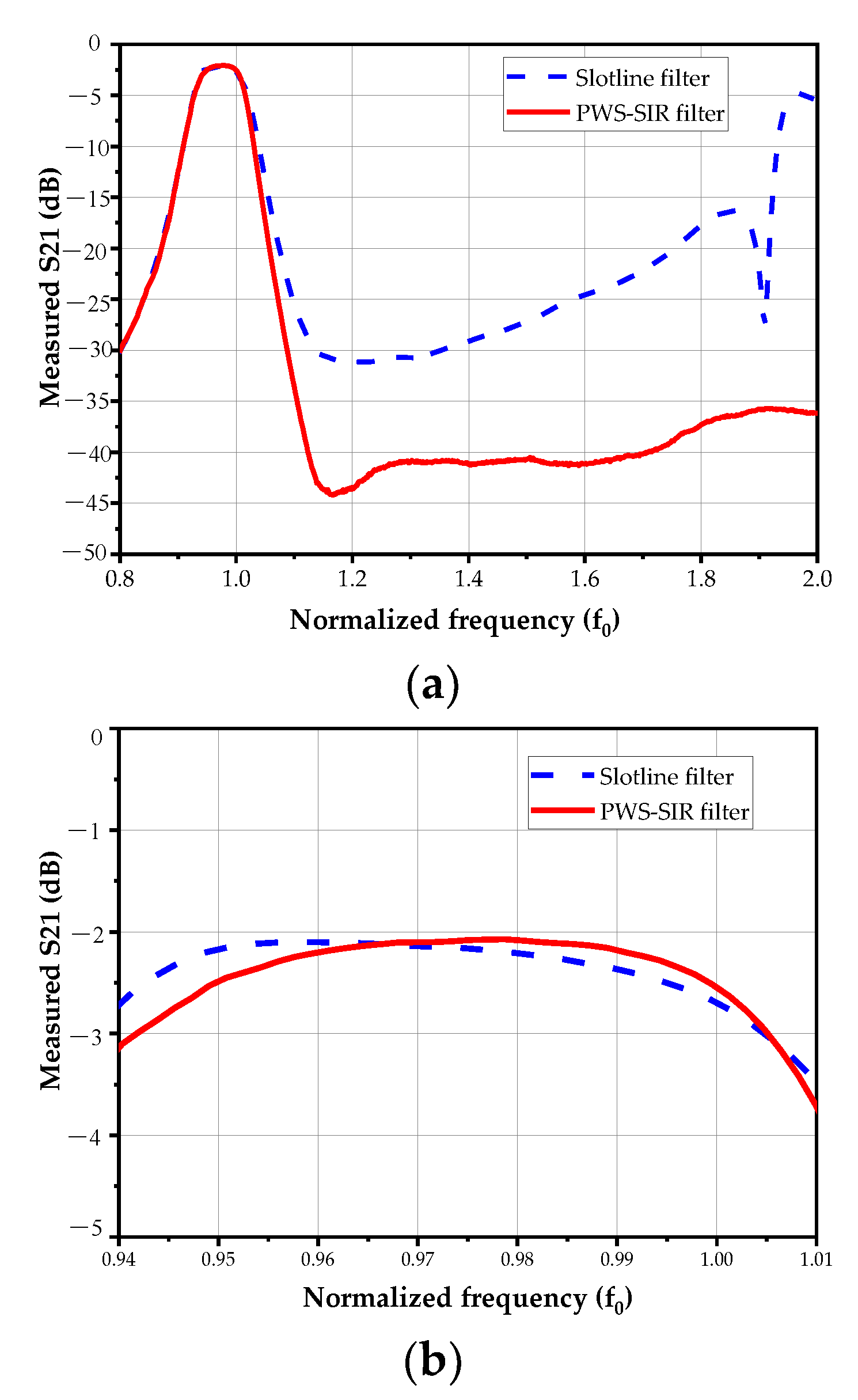
| Conductor Loss (%) | Dielectric Loss (%) | Radiation Loss (%) | Total Loss (%) | |
|---|---|---|---|---|
| PWS-SIR | 0.594 | 0.604 | 7.215 | 8.410 |
| CS-SIR | 0.553 | 0.572 | 12.975 | 14.095 |
| f0 /GHz | Insertion Loss/dB | Size /λ0 | Upper Stopband (>20 dB)/f0 | Structure | |
|---|---|---|---|---|---|
| [6] | 3 | 0.67 | 0.55 × 0.8 | 2.30 | Strip loaded CSL |
| [7] | 2.44 | 2 | 0.152 × 0.206 | Lower than 18 dB | CSL-MS 1 |
| [9] | 2.11 | 2 | 0.078 × 0.087 | 2.37 | Conductor-Backed CSL |
| [10] | 4.05 | 0.83 | 0.21 × 0.17 | 3.56 | CSL-SIR |
| [11] | 2.64 | 0.88 | 0.40 × 0.20 | 1.74 | CSL-SIR |
| [12] | 1.5 | 3 | 0.78 × 0.14 | 8.3 | MS-SIR |
| [13] | 2.5 | 2 | 1.04 × 0.39 | 6.4 | Wiggly-Line SIR |
| [14] | 1.51 | 2.7 | 0.32 × 0.22 | 8.3 | MS-SIR |
| [17] | 1.5 | 2.52 | 0.16 × 0.12 | 11.3 | MS-SIR |
| [19] | 0.4 | 0.5 | 8.5 | Stub loaded MS | |
| [24] | 8.3 | 1.5 | 0.31 × 0.55 | 2.41 | Tapered MS |
| This work | 4.9 | 1.7 | 0.22 × 0.22 | 4.7 | PWS-SIR |
Publisher’s Note: MDPI stays neutral with regard to jurisdictional claims in published maps and institutional affiliations. |
© 2022 by the authors. Licensee MDPI, Basel, Switzerland. This article is an open access article distributed under the terms and conditions of the Creative Commons Attribution (CC BY) license (https://creativecommons.org/licenses/by/4.0/).
Share and Cite
Yang, L.; Lu, C.; Wang, J.; Li, S.; Zhao, H.; Yin, X. Postwall-Slotline Stepped Impedance Resonator and Its Application to Bandpass Filter with Improved Upper Stopband. Electronics 2022, 11, 851. https://doi.org/10.3390/electronics11060851
Yang L, Lu C, Wang J, Li S, Zhao H, Yin X. Postwall-Slotline Stepped Impedance Resonator and Its Application to Bandpass Filter with Improved Upper Stopband. Electronics. 2022; 11(6):851. https://doi.org/10.3390/electronics11060851
Chicago/Turabian StyleYang, Liang, Cheng Lu, Jialin Wang, Shunli Li, Hongxin Zhao, and Xiaoxing Yin. 2022. "Postwall-Slotline Stepped Impedance Resonator and Its Application to Bandpass Filter with Improved Upper Stopband" Electronics 11, no. 6: 851. https://doi.org/10.3390/electronics11060851
APA StyleYang, L., Lu, C., Wang, J., Li, S., Zhao, H., & Yin, X. (2022). Postwall-Slotline Stepped Impedance Resonator and Its Application to Bandpass Filter with Improved Upper Stopband. Electronics, 11(6), 851. https://doi.org/10.3390/electronics11060851






